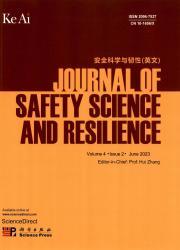A position-aware attention model based on double-level contrastive learning for hyper-relational knowledge graph representation in emergency management
IF 3.4
Q1 PUBLIC, ENVIRONMENTAL & OCCUPATIONAL HEALTH
引用次数: 0
Abstract
Effective emergency management relies on timely risk identification and decision-making, wherein natural language processing plays a vital role. Hyper-relational knowledge graph (HKG) representation, which embeds entities and their complex relations into latent space, provides a strong foundation for supporting emergency responses. Existing methods consider either inter-entity or inter-fact dependencies, leading to the loss of interaction information at the unconsidered level (fact level or entity level). To address the above issue, we propose a position-aware attention model based on dual-level contrastive learning (PDCL) for HKG representation. First, the complete and co-occurrence graphs were constructed and encoded using different graph convolutional networks, generating different embedding views for entities and facts. Second, entity-level and fact-level contrastive objectives were designed to enhance information exchange between the two levels in a self-supervised manner. Finally, a linear transformation corresponding to the ordinal information of each element was used to integrate positional constraints into the representation of the HKG. Experimental results for three benchmark datasets showed that the PDCL model outperformed existing state-of-the-art methods. Especially, MRR and Hits@1 values could be improved by up to 1.8% and 3.3%, respectively.
基于双层次对比学习的位置感知注意模型在应急管理中的超关联知识图表示
有效的应急管理依赖于及时的风险识别和决策,其中自然语言处理起着至关重要的作用。超关系知识图(HKG)表示将实体及其复杂关系嵌入到潜在空间中,为支持应急响应提供了坚实的基础。现有的方法要么考虑实体之间的依赖,要么考虑事实之间的依赖,导致在未考虑的级别(事实级别或实体级别)丢失交互信息。为了解决上述问题,我们提出了一种基于双层次对比学习(PDCL)的位置感知注意模型。首先,使用不同的图卷积网络构造和编码完备图和共现图,生成实体和事实的不同嵌入视图;其次,设计实体级和事实级对比目标,以自我监督的方式加强两层之间的信息交流。最后,利用各元素序数信息对应的线性变换,将位置约束整合到HKG的表示中。三个基准数据集的实验结果表明,PDCL模型优于现有的最先进的方法。特别是,MRR和Hits@1值可分别提高1.8%和3.3%。
本文章由计算机程序翻译,如有差异,请以英文原文为准。
求助全文
约1分钟内获得全文
求助全文
来源期刊

安全科学与韧性(英文)
Management Science and Operations Research, Safety, Risk, Reliability and Quality, Safety Research
CiteScore
8.70
自引率
0.00%
发文量
0
审稿时长
72 days
 求助内容:
求助内容: 应助结果提醒方式:
应助结果提醒方式:


